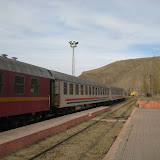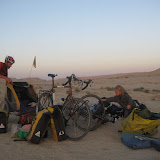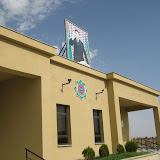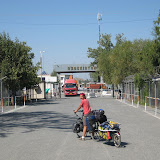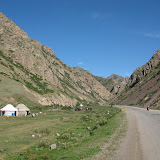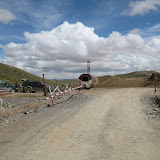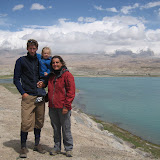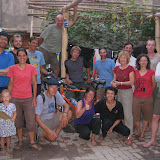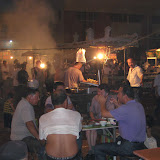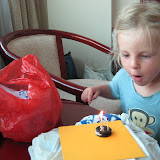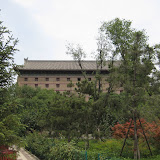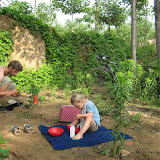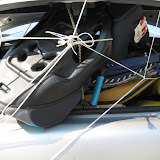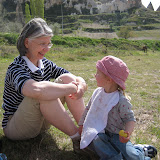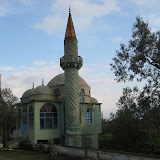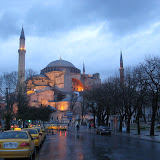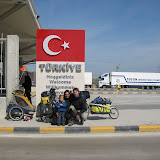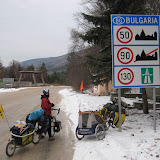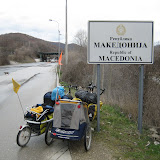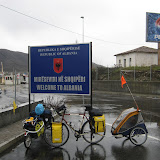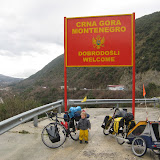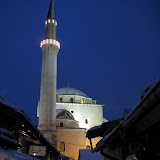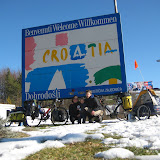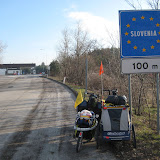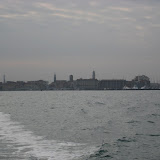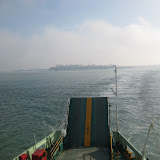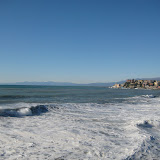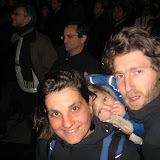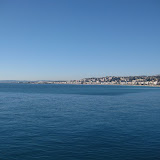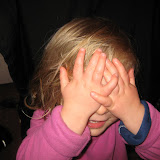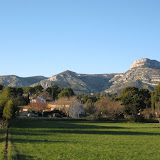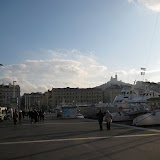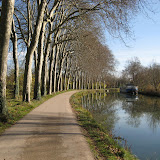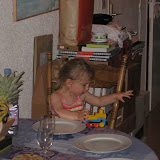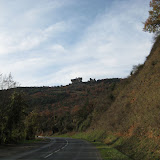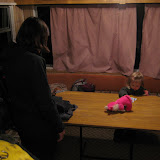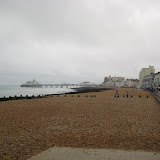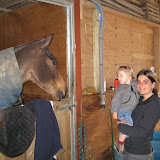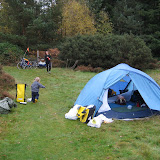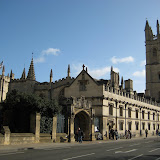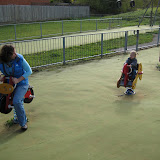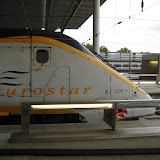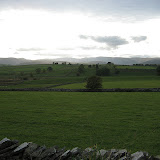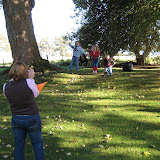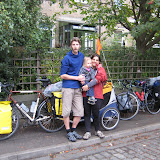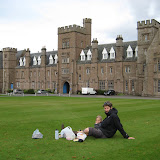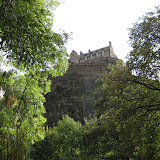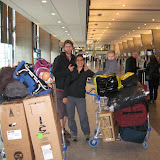Bonjour,
11080 kms, pas tout a fait 11 mois de voyage, 3 mois pour traverser la Chine, nous sommes arrives a Kashgar. Nous sommes heureux! Satisfaits d'etre passes chez les Hans, les Huis, et les Ouighours.
En plus de ses 23 provinces, 2 zones speciales (Hong-Kong et Macau), 4 villes metropolitaines, la Chine inclue 5 regions autonomes ou les minorites nationales ne sont pas forcement majoritaires dans leur region respective. Une dont on entend tres evidemment parler est le Tibet, que les Chinois ont renomme Xizang. Originairement, le Tibet avait pour territoire ce qui est maintenant la province du Qinghai et la region autonome du Xizang. La frontiere entre les 2 a ete tracee plus ou moins arbitrairement, rien ne les distingue a part une ligne tracee sur une carte, l'une est maintenant une province et l'autre une region autonome. La region du Qinghai n'est pas accessible partout. Certaines routes sont parfois, de facon aleatoire, fermees aux touristes. Depuis la fondation du Parti Communiste Chinois, elle a ete une sorte de "Siberie chinoise" avec de nombreux camps de travail et prisons isolees. C'est aussi une "poubelle nucleaire" avec beaucoup de "bases secretes". C'est une province de culture tibetaine (le Dalai Lama actuel est ne dans cette region), excepte sa capitale Xining dans l'est de la province qui est Han. La plus petite region autonome est celle du Ningxia, region designee pour les Huis, les Chinois musulmans. Pourtant, on retrouve 80% des Huis a l'exterieur de leur region, et leur region est constituee a 62% de Hans. C'est une region tres pauvre, une des raisons qui explique la migration des Huis dans d'autres provinces. Nous en avons beaucoup rencontre dans la province du Gansu, et c'est avec eux que nous avons goute a nos premieres brochettes de mouton, un delice! Les Huis seraient des descendants de marchands perses et arabes venus s'etablir en Chine sous la dynastie Tang (618-907apres J.C). Tres peu les distingue des Chinois Hans, excepte leur attachement a l'Islam. La Mongolie Interieure, au sud de la Mongolie, et le Guangxi sont aussi 2 autres regions autonomes dont je ne connais pas grand chose. Finalement, la derniere et non la moindre dont on n'entend pas assez parler est le Turkestan Oriental, renomme Xinjiang par les Chinois, qui veut d'ailleurs dire "nouvelle frontiere", terre des Ouighours qui nous plait bien! Les Ouighours constituent 45% de la population, le total des minorites ethniques (Ouighours, Kazakhs, Huis, Kirghizs, Mongols et autres) est de 59%. Les Hans sont presents a 41% et ce chiffre ne cesse de grandir... Je pourrai faire un message a lui seul pour parler de tout ca. Ce sera pour plus tard!
Je repars vers l'est. Nous avons quitte l'Empire du Milieu a Jiayuguan dans le Gansu. Nous y avons vu la fin de la Grande Muraille ainsi que le fort, qui controlaientt l'acces a ceux venant de l'ouest ayant traverse le Turkestan et ceux venant du nord arrivant de la Mongolie. C'est a partir de ce moment ou nous sommes entres dans le monde des caravanes mais nous y avons trouve tres peu de traces. A Dunhuang, nous avons visite les Grottes de Mogao tres impressionnantes. Elles sont ouvertes au public depuis 1980, seules 40 restent ouvertes au public, par roulement, dont dix en permanence, sur un ensemble de 492 temples bouddhistes. Le nombre de grottes creusees dans la paroi rocheuse reste indetermine. Ces grottes constituaient des lieux de culte d'une grande importance, sur la route de la soie. Les pigments utilises pour les couleurs des peintures murales viennent de partout, d'Afghanistan par exemple pour le bleu du lapis-lazuli. Leur réalisation s'est étalée sur une longue période allant du 4e siecle (dynastie Wei 386-581) au 14e siecle avec un point culminant sous la dynastie Tang (618-907). Autour de 1900, une petite grotte murée fut découverte de façon accidentelle; elle s'avéra contenir plusieurs dizaines de milliers de documents, de statuettes et d'objets divers, souvent vieux de plus de 1 000 ans. Une grande partie de ces trésors culturels ont été achetés par les explorateurs occidentaux, en particulier Sir Aurel Stein et Paul Pelliot. Il ne reste donc plus de manuscrits en Chine, et les Chinois aimeraient bien sur en recuperer... Les Grottes ont toutefois etaient epargnees de la Revolution Culturelle sous la demande de la femme de Mao, Jiang Qing. Ce sont les peintures murales, si bien preservees, qui sont magnifiques. Elles sont surtout a thematique religieuse mais certaines retracent egalement la vie quotidienne des moines. A ne pas manquer si elles ne se trouvent pas tres loin de votre route! :)
En quittant l'Empire du Milieu, nous avons quitte les Hans, meme si nous en avons finalement trouve ensuite habitant a peu pres dans toutes les grandes villes. Ils s'installent de plus en plus partout... Voici quelques caracteristiques hans dont je n'avais pas encore parle.
Les Hans ont l'habitude de faire une courte reunion de tous les employes d'un restaurant, d'une epicerie, d'un hotel en public. Ils sont tous alignes sur le trottoir ou devant le comptoir des viandes du supermarche et ecoute leur superviseur pendant quelques minutes.
Les hommes Hans boivent beaucoup de bieres. Dans la campagne, mais aussi en ville. Ils sortent dans les restaurants, boivent comme des trous, rentrent a l'hotel completement saouls (c'est la ou on les voit avant et apres), a l'occasion se fachent a la reception. Une femme (epouse ou amante je ne sais trop) est toujours la pour l'accompagner, le tirer par le bras s'il s'enerve trop, et surtout, elle garde tout son calme!
Les femmes Hans ont l'air d'avoir "peur" du soleil de la meme facon que les femmes en Amerique Latine. Elles pensent que j'ai une sorte de maladie quand elles voient mon bronzage. Soit elles utilisent un parapluie-parasol pour se proteger du soleil quand elles sont en ville, soit lorsqu'elles travaillent dans les champs ou voyagent en velo ou scooter, elles sont toutes couvertes. Elles portent un foulard ou un chapeau, se couvrent la bouche par un masque (pour se proteger de la poussiere aussi peut-etre) et portent des extensions a leurs manches courtes. Les hommes ne font pas ca du tout. Le soleil est-il plus dangereux pour les femmes que pour les hommes?
Tout au long de notre traversee du pays, nous avons remarque que les rivieres etaient enormement assechees, d'autant plus ici dans l'ouest. Mais en contrepartie, beaucoup d'eau circule dans les canaux d'irrigation utiles aux cultures et passant dans les villages. Beaucoup de ces canaux ont ete construits sous Mao et la construction avait entraine une grande catastrophe humaine. Le "Grand Bond en Avant" (1958-1960) visait a stimuler la production par la collectivisation agricole. Un des objectif etait d'accroitre la production d'acier. Chaque personne avait un quota a respecter. Les paysans ont fondu leur outils pour respecter leur quota. Ils etaient donc plus occupes a cela qu'a leur production agricole. C'est aussi cet acier qui a servi a construire les petites portes que l'on retrouve dans tous les canaux. Ajoute a cela, 1959 fut une terrible annee pour la meteo agricole, et en 1960 les Soviets ont retire leur aide. Le pays est entre dans une grande famine. Ces canaux d'irrigation ont l'air desormais de bien fonctionner. Ils sont secs ou remplis a certaines heures. On n'a pas su qui controlait l'ouverture des portes. Pour nous en tout ca, ils etaient tres utiles pour nous rafraichir.
Cote equipement. Une sacoche de decousue mais reparee a Xi'an. Une tente plus vraiment impermeable et pourtant pas vieille, une chance nous n'avons pas eu souvent de grandes pluies. Lorsque ca arrive, nos tapis de sol sont sur un fin coussin d'eau. La pompe du rechaud ne fonctionne plus bien. On n'utilise plus d'essence. On a une reserve de bonbonnes de gaz. Rupert a brule son tapis de sol en mettant le rechaud dessus en voulant faire la cuisine a l'interieur. Bravo! Une patch et hop repare! Le tapis n'etait pas encore trop troue. La jante de la roue arriere du velo de Rupert a craque. Il a vu ca a Xi'an, en a achete une sur internet et l'a faite envoyer a Lanzhou. Il a roule avec legerete entre ces 2 villes! Le cable du derailleur ailleurs du velo de Rupert a ete abime et casse lorsqu'on a pris l'autobus entre Dunhuang et Turpan. Il a roule avec 3 vitesses jusqu'a Kaxgar. Bravo Il a trouve un bon magasin de velo qui savait comment le changer ici. On a eu plusieurs crevaisons consecutives dues a l'usure des pneus. Changer ca en plein desert, super! Oceanne a perdu son canard-doudou il y a longtemps maintenant mais a tres bien remplace ca par un bout de tissu! Elle a aussi perdu son chapeau pour le soleil et une sandale. Tout ca est tombe de la remorque, par accident ou volontairement, et elle ne le dit pas. En pleine grande montee, Rupert est descendu de 2 kms et remonte de 2 kms pour retrouver sa sandale. Coquine!
Et cote route, nous avons bien sur traverse et traverse le desert. Pas si difficile toutefois. En quittant Turpan, nous avons tout de suite frappe une tempete de vent sans transport de sable, une autre fois de l'ouest, une autre fois le vent de face. Impossibe d'avancer. Nous sommes montes dans une camionnette pour 15 kms puis la route a change de direction. Un vent de travers qui s'apprivoise. Puis nous sommes montes du niveau de la mer a Turpan jusqu'a 1800m en 60 kms. Cela nous a pris 2 jours. Nous avons campe dans la montagne. On pensait etre seuls, c'etait 60 kms sans village, mais finalement sans le vouloir (on n'a pas vu, c'etait dans un virage), nous nous sommes arretes a quelques metres du seul kiosque de vente de pasteques. Un couple et un enfant sont venus nous voir et nous ont invites. Oeufs durs et pasteque le soir, oeufs durs et pasteque le lendemain matin. Il y avait aussi une petite source d'eau. On a passe un peu de temps avec les camionneurs qui s'arretaient, sympa. L'homme nous a offert de l'argent (mis dans la main d'Oceanne) quand on est reparti. Impossible de lui redonner. Vraiment genereux. Plusieurs fois sur la route on nous a offert de l'eau, et du melon, et de la pasteque, et du melon, et de la pasteque, et du melon, et de la pasteque. Je ne peux plus! Pour le reste de la route, nous avons traverse de nombreuses villes, ce qui nous permettait de nous arreter environ tous les 3 jours pour prendre un jour de repos a la fraicheur, faire l'epicerie, marcher dans la ville. Il y a aussi de nombreux villages, tous irrigues par l'eau descendant des Tian Shan. Une seule section de 400 kms entre Aksu et Artux fut un peu plus longue. 2 nuits de camping, 1 nuit dans l'hotel de camionneur du village. Les nuits sous la tente ne furent pas tres agreables. Tres chaud, avec beaucoup de moustiques, on ne pouvait pas ouvrir les portes. On a aussi eu droit a une 3e tempete de vent, courte, mais cette fois transportant du sable. On s'est reveille avec un fin tapis de sable dans la tente. Reveilles a 6h par la chaleur, rien a faire d'autre que pedaler jusqu'a ce qu'il fasse frais a 18h, nous avons fait plus de 100kms par jour en moyenne sur 4 jours. Nous avons eu un vent dans le dos pendant 2 jours, cela aide beaucoup! Mais cette section de route est tres belle, les Tian Shan, tres colorees, sont tres proches de nous. Meme si c'etait lors de journees nuageuses (tant mieux, il faisait moins chaud), c'etait deja tres beau.
Nous sommes arrives a Kaxgar il y a maintenant une semaine, bien fatigues. Apres Aksu, c'etait bien sur notre entiere motivation. Vous saurez tout sur cette semaine et sur ce qui va suivre (le Kirghistan) dans un autre message, car celui-la est deja tres long!
A bientot. Bises a tous,
Dorothee
Afficher Our route sur une carte plus grande
Monday 23 August 2010
Sunday 22 August 2010
Perpetuating Horizons
Hi there once again,
We are now in Kashgar. We DID China and survived! This particular town has become almost mythical to us. We have come all the way from the other side of this country, the city of Beijing being over 4650 km's of pedalling away. Same country but so incredibly different. Not only did we have to bike through 1800 km's of desert to get here but this historical trading post at the junction of many arms of the silk road is in a totally unique location. The Tian Shan mountains and the border of Kyrgyzstan are just to the north. The Pamir ranges and Tajikistan are to the west and south including our friend, Afghanistan. Pakistan is only 350 km's away to the south along the Karakorum highway which begins in Kashgar. The second highest mountain in the world, K2 is a similar distance away in the same region. Kazakstan is also very close. It feels strange to come all this way in very monotonous landscapes in one single country and then have so much happening in all different directions. I imagine it could be like following a very long tunnel for a very long time and then being let out into a huge valley full of lakes, mountains, glaciers, flowers and all the animals under the sun. We are not there yet however. We must arrange our transport to Kyrgyzstan in the next couple of days as the border over the Torugart pass to Naryn and eventually Bishkek, where we must try and acquire a visa for Uzbekistan, is closed to independent travellers. We must therefore go in some kind of jeep and pay through the nose for the pleasure. Nice.
Leaving Jiayuguan where l last wrote was admittedly a little bit depressing. Over 2000 km's of desert awaited us and along with that we had the uncertainty of maybe or maybe not extending our stay in China which we dearly wanted to even if we were a little daunted by the huge distances of aridness! Our plan was to head to Dunhuang which was a relatively large detour into even more intense desert to see some famous buddhist cave art before continuing on the main route west via Turpan which is below sea level before continuing over the Tian Shan range and then aside it for the long drag to Kashgar. So we set off to Dunhuang, myself in anxious spirits of the job in hand. Tired of the family dynamic it has to be said as well. Oceanne is our ticket to some amazing experiences and this trip would be nothing like it has been without her but and there is a but, we continue to be sometimes exhausted and for me this was one of those times. The added logistics and weight of now having to find and travel with up to 14 litres of water means that when the day is over and we are exhausted, poor Oceanne is on top form and needing to run around and play. It is still very hot at these times in the evening and the want and need to lie down on the ground and maybe put up the tent when your energy returns and then cook supper is very tempting. This is not possible so therefore nerves are often ragged and tensions do occur which is not great but it's difficult to keep a lid on things!
After the last of the autoroute which we took in parts to the very end before the town of Anxi we were within 120 km's of Dunhuang. The autoroute will eventually go all the way to Kashgar but for now China continues to be a country in the process of construction and transition as new autoroutes and high speed rail links are built all around this huge land. We had arrived at 9 p.m the night before after a huge day of 140 km's. Dorothee had suffered mild sunstroke after being exposed to the heat for too long but we were confident that a tailwind would push us the remaining distance to Dunhuang. It started well but then after a few dust devils appearing on my left, the wind turned 180 degrees in an instant and we were in a full blown sand storm with the wind so strong on the nose that it took a huge and l mean huge effort to grind forward at around 8 km/h. I have never felt such a hot strong wind and even drafting wasn't helping the cyclist behind. We were invited into a house and fed the famous 'lahman' which is specially made stretched noodles normally served with stir fried mutton in vegetables. This time it wasn't so elaborate but these people were extremley kind and genuine and of course did not have much. I remember their crunchy green beans in particular as a good memory! We set out again in this fierce wind with myself thinking that l would not be beaten by a bit of wind. Around 12 km's later and totally exhausted and fast running out of water with none available for the next 90 km's to Dunhuang, we gave up while being offered nearly an entire water melon by a truck who had a flat. The amount of water we drank per hour was incredible in that storm. We could have put the tent up and the storm would or should have died down through the night and we could have carried on the next day but nothing was certain and we might not have had enough water for the following day. Not risks you take with a child. Alone, most definetly!! We got a lift almost immediately and arrived in Dunhuang an hour or so later. Forced to pay for the lift before l could offer anything. That is the way in China for hitching. It was the right decision because Oceanne came down with a stomach issue soon after arriving which lasted for a week and she lost a lot of fluids and also weight. She is now recovered but we were of course very worried. Dorothee caught it also in Dunhuang but was bedridden for only a day. I mysteriously got it a week later in Turpan and felt weak for a couple of days.
Dunhuang was definetly worth the detour. The Magao caves are out of this world and the sand dunes or Mingsha mountains that lie 6 km's to the south of the town are those perfectly formed crests that you think only exist in the deepest, darkest Sahara. Some are over 1500 metres high and just too tempting to get away from the crowds of Chinese tourists in their orange flourescent sand boots on camel rides. Burning feet but an incredibly rewarding experience in total silence and very high up, looking down on the oasis towards the north and sand upon sand to the south. We met a German cyclist after leaving Jiayuguan who on mentioning the Magao caves said that caves were not his thing but l can tell you, they're maybe not my thing either but you cannot leave not amazed. The art and sculpture cannot be compared and l don't know how the cyclist could make that comment without even seeing it or even taking the detour to Dunhuang. Nutter. I'm not the judgemental type of course! We tried to extend our visa in town during our sickness period but they were having none of it saying it was too early. We only had a week left and we questioned, well what happens if we are refused as we expected but that didn't seem to make a difference to the PSB or public security bureau as the police are called. Our plan B was to go to Hami by bus which was the next town on our route, to try there. All was going well and we had our ticket and had even showed our entire luggage collection to the bus station so they could realise our situation. The bus was at an early time in the morning but we got there in good time. The driver would not take us though! More frustration. I knew we should have biked instead l muttered to myself! It is true it was not a huge bus but come on, they knew! They said come back tomorrow but l was having none of that. Why should tomorrow be any different. Plan C was to ask about a bus to Turpan, the town after Hami where we knew we had a good chance of a visa extension as a French family had asked there for a third extension and succeeded only two years ago in an exact copy of our current situation. To cut a long story short we were helped, not really great help, to push and sometimes ram our bikes into a small compartment on a sleeper bus to Turpan. All the rest of the large baggage compartment was taken up by huge sacks of grain that were on the bus before it arrived at the bus station. We of course had to pay for our bikes like we had to pay the guy who gave us a lift before Dunhuang. The bus journey was interesting. 14 hours with Oceanne still sick and bumping around trying to change nappies and sleep made it something to forget! I just wished Oceanne would get better at this point and hoped that we would get this extension to make all this effort worth it. Getting off the bus and realising my rear derailleur cable had been damaged meaning l now had only 3 speeds with just the front derailleur made my mood all the more better.
Turpan is the hottest place in China with a record temperature of above 49 degrees mostly due to the fact that it is in a basin that is below sea level and is the second lowest depression on earth after the dead sea. In this month of July which is the hottest, walking slowly and staying cool was very important. That kind of heat makes feeling active virtually impossible. But we got the extension. Yes! I was forced to clean up an accident by Oceanne when the toilet hadn't come quick enough the day before as we picked up our new visa but that was a small price to pay! We visted certain sites in and around Turpan during this time as Oceanne got better including the ingenious underground irrigation system called a Karez. A Karez brings groundwater gradually down a slope from beneath mountains, in this case the Tian Shan keeping it always underground until it reaches the point where it is needed at the bottom of the valley. Kept underground to limit evaporation in the intense heat and to keep it fresh and clean. We could go underground to see a real one which was interesting and great to have a drink as each year there are more of these systems that are abandoned. A bit like an animal going extinct. It is said that only specific people could build a Karez and these men were incredibly valued! I tried to get someone to fix my cable at this time but the simple bike guys who you find in the street had no idea about my integrated shifter and infact were close to destroying it altogether. The best l could do was to jam it in the easiest gear as we had a 60 km climb up to 1800 metres from below sea level soon after Turpan after which l would jam it in a gear better suited to the flat roads to Kashgar as we crossed the eternal desert. It was a long shot but l needed to get to a bigger town for a new cable where maybe l would have a go at changing it but in all honesty l was a bit of a chicken in trying as those integrated shifters are tricky or so l thought. I actually got a cable in Korla 380 km's after Turpan but not being confident enough with cables, ended up not changing it until l found a really good bike shop here in Kashgar hence riding the 1400 km's from Turpan on just the front derailleur. During this cross desert odyssey we also achieved our largest distances, one day doing 153 km's in a long day of seven hours in the saddle and during a period where we did 460 km's in 4 days. I had killer diarrhoea l am afraid to admit during this time so for me l was dying on my bike. It was the worst l have ever felt on a bike and getting to Kashgar felt all the more better for it.
We had more sand storms on the road. One where we were again forced to take a lift but only for 15 km's, this time where instead of battling a head-on storm we were taken to an intersection where we turned and could lean full force into the storm as it now hit us side-on. Hard but at least better than in the face. This time l can say the wind was so strong that l didn't know l could see that type of wind in a desert. I have a video! One night we also had one while camping and the sand was so fine it filtered through even the netting of the tent so everything was covered and l wasn't sure if l was itching from mosquito bites from when we were having supper or the fine sand on my mattress! You would think mosquitoes don't exist in the desert but in this desert they sure did. Oceanne had at least 50 bites at a time even with repellent. They were fierce and Oceanne has pretty bad reactions to them followed by itching for weeks which is not so pleasant for her. Basically we have had trials but we got here and believe me we often had wind in the back as well which was a huge blessing in the long hot straights of the desert.
While we've been here in Kashgar, we took a jeep up the famous Karokorum highway over 4000 metres to Taskurgan which is close to the Pakistan border and we camped for a night on the shores of Karakul lake below two massive peaks that reached up to nearly 7800 metres with huge glaciers coming down their flanks. One of them was the revered Muztagh Ata which at 6 a.m and sunrise was a sight l won't forget as the whole mountain was absolutely clear from where we were camped at 3600 metres.
I would say that, yes, Kashgar has lived up to it's expectation on our parts. The Uighur population is still thriving here even if the Han Chinese are destroying their homes to make way for modernisation and yet more modernisation. The main Bazaar and livestock market are sights that can't be missed. A massive bull is going for around 1000$ or a donkey for 200$ but l coulden't afford it. I bought a nice knife though as that was affordable and every Uighur man carries one so why not. May not be able to get it back to Canada though. We are staying in the old quarter in a hostel housed in an old courtyard house. There are an incredible 15 other travellers by bike at the moment staying in this place as it's a major junction for cyclists going west to central Asia like us, south to Pakistan and east to mainland China with the huge majority going east infact. I think we are the only one's going west!? Gooooooo west...
We are now just awaiting our private jeep on wednesday to Kyrgyzstan where we should, you never know, get on our bikes. Central Asia is waiting for us. I have a new tyre from Kashgar and we are ready to go. I can't get any tubes though. You woulden't believe that we had 10 flats on the road from Turpan to here but we did which means the tubes have an amazing assortment of patches on them and l can't trust them anymore. Hardly any roads are of the asphalt variety in Kyrgyzstan either which should be interesting. Must ask my sister or somebody to send me some. Love to all.
Rupert.
11,161 km's and 28 flats
We are now in Kashgar. We DID China and survived! This particular town has become almost mythical to us. We have come all the way from the other side of this country, the city of Beijing being over 4650 km's of pedalling away. Same country but so incredibly different. Not only did we have to bike through 1800 km's of desert to get here but this historical trading post at the junction of many arms of the silk road is in a totally unique location. The Tian Shan mountains and the border of Kyrgyzstan are just to the north. The Pamir ranges and Tajikistan are to the west and south including our friend, Afghanistan. Pakistan is only 350 km's away to the south along the Karakorum highway which begins in Kashgar. The second highest mountain in the world, K2 is a similar distance away in the same region. Kazakstan is also very close. It feels strange to come all this way in very monotonous landscapes in one single country and then have so much happening in all different directions. I imagine it could be like following a very long tunnel for a very long time and then being let out into a huge valley full of lakes, mountains, glaciers, flowers and all the animals under the sun. We are not there yet however. We must arrange our transport to Kyrgyzstan in the next couple of days as the border over the Torugart pass to Naryn and eventually Bishkek, where we must try and acquire a visa for Uzbekistan, is closed to independent travellers. We must therefore go in some kind of jeep and pay through the nose for the pleasure. Nice.
Leaving Jiayuguan where l last wrote was admittedly a little bit depressing. Over 2000 km's of desert awaited us and along with that we had the uncertainty of maybe or maybe not extending our stay in China which we dearly wanted to even if we were a little daunted by the huge distances of aridness! Our plan was to head to Dunhuang which was a relatively large detour into even more intense desert to see some famous buddhist cave art before continuing on the main route west via Turpan which is below sea level before continuing over the Tian Shan range and then aside it for the long drag to Kashgar. So we set off to Dunhuang, myself in anxious spirits of the job in hand. Tired of the family dynamic it has to be said as well. Oceanne is our ticket to some amazing experiences and this trip would be nothing like it has been without her but and there is a but, we continue to be sometimes exhausted and for me this was one of those times. The added logistics and weight of now having to find and travel with up to 14 litres of water means that when the day is over and we are exhausted, poor Oceanne is on top form and needing to run around and play. It is still very hot at these times in the evening and the want and need to lie down on the ground and maybe put up the tent when your energy returns and then cook supper is very tempting. This is not possible so therefore nerves are often ragged and tensions do occur which is not great but it's difficult to keep a lid on things!
After the last of the autoroute which we took in parts to the very end before the town of Anxi we were within 120 km's of Dunhuang. The autoroute will eventually go all the way to Kashgar but for now China continues to be a country in the process of construction and transition as new autoroutes and high speed rail links are built all around this huge land. We had arrived at 9 p.m the night before after a huge day of 140 km's. Dorothee had suffered mild sunstroke after being exposed to the heat for too long but we were confident that a tailwind would push us the remaining distance to Dunhuang. It started well but then after a few dust devils appearing on my left, the wind turned 180 degrees in an instant and we were in a full blown sand storm with the wind so strong on the nose that it took a huge and l mean huge effort to grind forward at around 8 km/h. I have never felt such a hot strong wind and even drafting wasn't helping the cyclist behind. We were invited into a house and fed the famous 'lahman' which is specially made stretched noodles normally served with stir fried mutton in vegetables. This time it wasn't so elaborate but these people were extremley kind and genuine and of course did not have much. I remember their crunchy green beans in particular as a good memory! We set out again in this fierce wind with myself thinking that l would not be beaten by a bit of wind. Around 12 km's later and totally exhausted and fast running out of water with none available for the next 90 km's to Dunhuang, we gave up while being offered nearly an entire water melon by a truck who had a flat. The amount of water we drank per hour was incredible in that storm. We could have put the tent up and the storm would or should have died down through the night and we could have carried on the next day but nothing was certain and we might not have had enough water for the following day. Not risks you take with a child. Alone, most definetly!! We got a lift almost immediately and arrived in Dunhuang an hour or so later. Forced to pay for the lift before l could offer anything. That is the way in China for hitching. It was the right decision because Oceanne came down with a stomach issue soon after arriving which lasted for a week and she lost a lot of fluids and also weight. She is now recovered but we were of course very worried. Dorothee caught it also in Dunhuang but was bedridden for only a day. I mysteriously got it a week later in Turpan and felt weak for a couple of days.
Dunhuang was definetly worth the detour. The Magao caves are out of this world and the sand dunes or Mingsha mountains that lie 6 km's to the south of the town are those perfectly formed crests that you think only exist in the deepest, darkest Sahara. Some are over 1500 metres high and just too tempting to get away from the crowds of Chinese tourists in their orange flourescent sand boots on camel rides. Burning feet but an incredibly rewarding experience in total silence and very high up, looking down on the oasis towards the north and sand upon sand to the south. We met a German cyclist after leaving Jiayuguan who on mentioning the Magao caves said that caves were not his thing but l can tell you, they're maybe not my thing either but you cannot leave not amazed. The art and sculpture cannot be compared and l don't know how the cyclist could make that comment without even seeing it or even taking the detour to Dunhuang. Nutter. I'm not the judgemental type of course! We tried to extend our visa in town during our sickness period but they were having none of it saying it was too early. We only had a week left and we questioned, well what happens if we are refused as we expected but that didn't seem to make a difference to the PSB or public security bureau as the police are called. Our plan B was to go to Hami by bus which was the next town on our route, to try there. All was going well and we had our ticket and had even showed our entire luggage collection to the bus station so they could realise our situation. The bus was at an early time in the morning but we got there in good time. The driver would not take us though! More frustration. I knew we should have biked instead l muttered to myself! It is true it was not a huge bus but come on, they knew! They said come back tomorrow but l was having none of that. Why should tomorrow be any different. Plan C was to ask about a bus to Turpan, the town after Hami where we knew we had a good chance of a visa extension as a French family had asked there for a third extension and succeeded only two years ago in an exact copy of our current situation. To cut a long story short we were helped, not really great help, to push and sometimes ram our bikes into a small compartment on a sleeper bus to Turpan. All the rest of the large baggage compartment was taken up by huge sacks of grain that were on the bus before it arrived at the bus station. We of course had to pay for our bikes like we had to pay the guy who gave us a lift before Dunhuang. The bus journey was interesting. 14 hours with Oceanne still sick and bumping around trying to change nappies and sleep made it something to forget! I just wished Oceanne would get better at this point and hoped that we would get this extension to make all this effort worth it. Getting off the bus and realising my rear derailleur cable had been damaged meaning l now had only 3 speeds with just the front derailleur made my mood all the more better.
Turpan is the hottest place in China with a record temperature of above 49 degrees mostly due to the fact that it is in a basin that is below sea level and is the second lowest depression on earth after the dead sea. In this month of July which is the hottest, walking slowly and staying cool was very important. That kind of heat makes feeling active virtually impossible. But we got the extension. Yes! I was forced to clean up an accident by Oceanne when the toilet hadn't come quick enough the day before as we picked up our new visa but that was a small price to pay! We visted certain sites in and around Turpan during this time as Oceanne got better including the ingenious underground irrigation system called a Karez. A Karez brings groundwater gradually down a slope from beneath mountains, in this case the Tian Shan keeping it always underground until it reaches the point where it is needed at the bottom of the valley. Kept underground to limit evaporation in the intense heat and to keep it fresh and clean. We could go underground to see a real one which was interesting and great to have a drink as each year there are more of these systems that are abandoned. A bit like an animal going extinct. It is said that only specific people could build a Karez and these men were incredibly valued! I tried to get someone to fix my cable at this time but the simple bike guys who you find in the street had no idea about my integrated shifter and infact were close to destroying it altogether. The best l could do was to jam it in the easiest gear as we had a 60 km climb up to 1800 metres from below sea level soon after Turpan after which l would jam it in a gear better suited to the flat roads to Kashgar as we crossed the eternal desert. It was a long shot but l needed to get to a bigger town for a new cable where maybe l would have a go at changing it but in all honesty l was a bit of a chicken in trying as those integrated shifters are tricky or so l thought. I actually got a cable in Korla 380 km's after Turpan but not being confident enough with cables, ended up not changing it until l found a really good bike shop here in Kashgar hence riding the 1400 km's from Turpan on just the front derailleur. During this cross desert odyssey we also achieved our largest distances, one day doing 153 km's in a long day of seven hours in the saddle and during a period where we did 460 km's in 4 days. I had killer diarrhoea l am afraid to admit during this time so for me l was dying on my bike. It was the worst l have ever felt on a bike and getting to Kashgar felt all the more better for it.
We had more sand storms on the road. One where we were again forced to take a lift but only for 15 km's, this time where instead of battling a head-on storm we were taken to an intersection where we turned and could lean full force into the storm as it now hit us side-on. Hard but at least better than in the face. This time l can say the wind was so strong that l didn't know l could see that type of wind in a desert. I have a video! One night we also had one while camping and the sand was so fine it filtered through even the netting of the tent so everything was covered and l wasn't sure if l was itching from mosquito bites from when we were having supper or the fine sand on my mattress! You would think mosquitoes don't exist in the desert but in this desert they sure did. Oceanne had at least 50 bites at a time even with repellent. They were fierce and Oceanne has pretty bad reactions to them followed by itching for weeks which is not so pleasant for her. Basically we have had trials but we got here and believe me we often had wind in the back as well which was a huge blessing in the long hot straights of the desert.
While we've been here in Kashgar, we took a jeep up the famous Karokorum highway over 4000 metres to Taskurgan which is close to the Pakistan border and we camped for a night on the shores of Karakul lake below two massive peaks that reached up to nearly 7800 metres with huge glaciers coming down their flanks. One of them was the revered Muztagh Ata which at 6 a.m and sunrise was a sight l won't forget as the whole mountain was absolutely clear from where we were camped at 3600 metres.
I would say that, yes, Kashgar has lived up to it's expectation on our parts. The Uighur population is still thriving here even if the Han Chinese are destroying their homes to make way for modernisation and yet more modernisation. The main Bazaar and livestock market are sights that can't be missed. A massive bull is going for around 1000$ or a donkey for 200$ but l coulden't afford it. I bought a nice knife though as that was affordable and every Uighur man carries one so why not. May not be able to get it back to Canada though. We are staying in the old quarter in a hostel housed in an old courtyard house. There are an incredible 15 other travellers by bike at the moment staying in this place as it's a major junction for cyclists going west to central Asia like us, south to Pakistan and east to mainland China with the huge majority going east infact. I think we are the only one's going west!? Gooooooo west...
We are now just awaiting our private jeep on wednesday to Kyrgyzstan where we should, you never know, get on our bikes. Central Asia is waiting for us. I have a new tyre from Kashgar and we are ready to go. I can't get any tubes though. You woulden't believe that we had 10 flats on the road from Turpan to here but we did which means the tubes have an amazing assortment of patches on them and l can't trust them anymore. Hardly any roads are of the asphalt variety in Kyrgyzstan either which should be interesting. Must ask my sister or somebody to send me some. Love to all.
Rupert.
11,161 km's and 28 flats
Subscribe to:
Posts (Atom)

